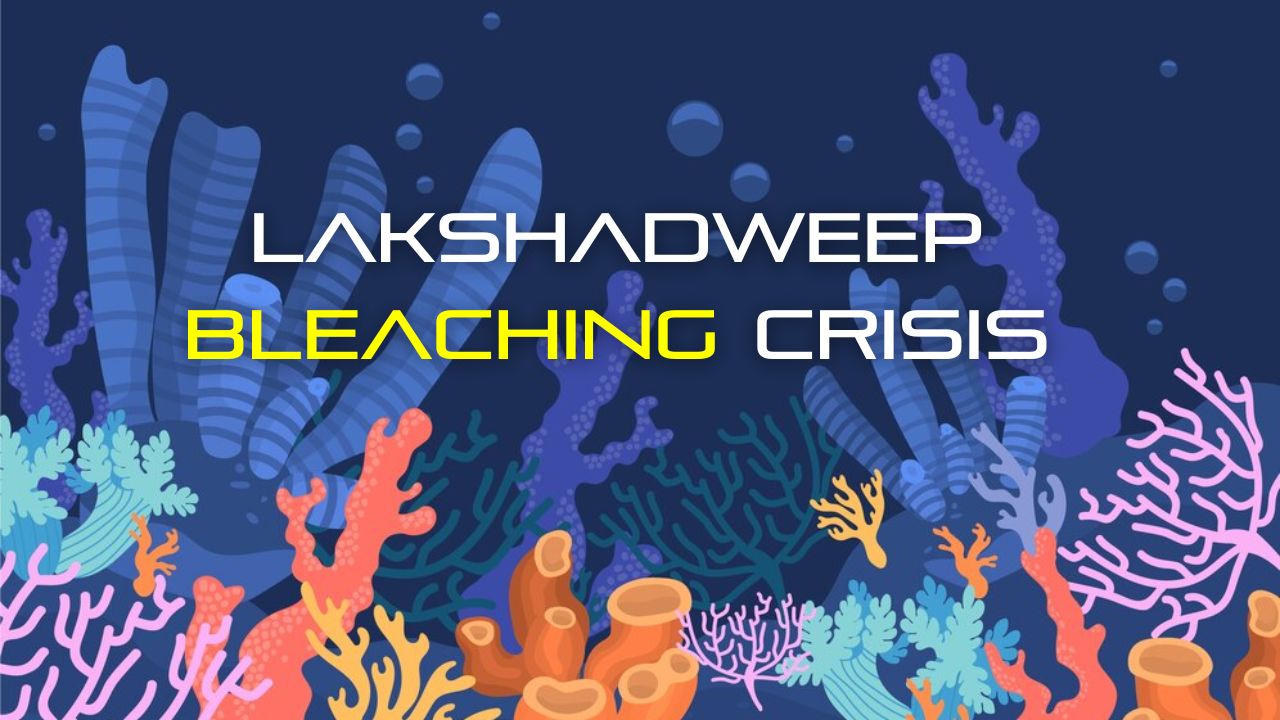Font size:
Print
Lakshadweep Bleaching Crisis
Context: Scientists have confirmed that Lakshadweep, an archipelago of 36 islands and a Union Territory of India, has been the most affected by coral bleaching.
More on News:
- The world is experiencing its fourth global coral bleaching event (GCBE4), the most severe on record, according to NOAA.
- Since early 2023, at least 67 countries and territories across the Atlantic, Pacific, and Indian Oceans have reported coral bleaching due to severe heat stress.
- As of May 23, 2024, GCBE4 has impacted more than 70.7% of the world’s coral reefs, surpassing the previous record of GCBE3 (2014-17), which affected 65.7%.
Coral Bleaching:
- Corals, belonging to the Cnidaria group, host algae called zooxanthellae for mutual benefit.
- Zooxanthellae provide corals with oxygen and nutrients through photosynthesis, while corals offer shelter. Stressors like light and temperature changes can lead to coral bleaching, where corals expel zooxanthellae, causing them to turn white and become vulnerable.
|
Types of coral reefs: Fringing Reefs: Common coral reefs that grow directly along coastlines and border islands. Barrier Reefs: Massive underwater structures parallel to coastlines, with a deep lagoon separating them. The Great Barrier Reef is a famous example. Atolls: Ring-shaped coral reefs with a central lagoon and a shallow rim above the water’s surface. |
Causes of Coral Bleaching:
- Rising Ocean Temperatures: Climate change is the primary driver. High water temperatures cause corals to expel algae (zooxanthellae), leading to bleaching.
- Without algae, corals lose their main food source and become vulnerable to diseases.
- Other Stressors:
- Pollution:
- Runoff introduces pollutants (fertilisers, sewage, sediments).
- Harmful to corals as it increases susceptibility to bleaching.
- Overfishing:
- Depleted fish populations disrupt the reef ecosystem’s balance.
- Increases algae growth that can suffocate corals.
- Ocean Acidification:
- Increased CO2 absorption raises acidity levels in oceans.
- It hinders coral skeleton formation and weakens their immune systems.
- Pollution:

Impacts of Coral Bleaching:
-
- For Coral Reefs:
- Death: Unaddressed stress leads to coral polyp death, leaving behind skeletal remains.
- Reduced Growth and Reproduction: Even surviving bleaching weakens coral, impeding growth and reproduction.
- Increased Susceptibility to Disease: Vulnerable corals are prone to diseases, further harming and killing them.
- For Coral Reefs:
-
- For Marine Ecosystems
- Loss of Habitat: Dead reefs mean lost habitats for fish, invertebrates, and plants, reducing biodiversity.
- Disruption of Food Chains: Coral loss disrupts food sources for many marine animals, impacting ecosystem balance.
- Reduced Coastal Protection: Degraded reefs diminish natural barriers against coastal erosion and storms, increasing the vulnerability of coastal communities.
- For Marine Ecosystems
-
- Socio-economic Implications:
- Fisheries: Declining fish populations affect livelihoods and food security.
- Tourism: Bleached reefs deter tourists, impacting local economies reliant on tourism.
- Coastal Protection Costs: The loss of reefs raises the costs of coastal protection measures, straining the finances of governments and communities.
- Socio-economic Implications:
-
- Global Implications:
- Reduced Carbon Sequestration: Healthy reefs absorb CO2, aiding in climate change mitigation.
- Loss of Biodiversity: Coral reefs, vital for marine biodiversity, suffer losses impacting aquatic diversity.
- Global Implications:
Initiatives:
- Global Initiatives:
-
-
- International Coral Reef Initiative (ICRI): Facilitates collaboration among governments and organisations to address coral reef issues globally.
- Global Coral R&D Accelerator Platform: Focuses on accelerating research and development efforts aimed at coral reef conservation.
-
- India:
-
-
- Conservation and Management of Mangroves and Coral Reefs: This is a central sector scheme under the National Coastal Mission Program aimed at conserving coastal environments while promoting sustainable development, revenue generation, and employment.
-
- Technological Innovations:
-
-
- Cyromesh: Technology for coral larvae preservation, potentially creating a bank of genetically diverse coral larvae.
- Biorock: Utilises low-voltage electrical currents to enhance coral reef growth by accelerating mineral accretion, mimicking natural limestone reefs.
-
Coral reefs in India:
- Gulf of Mannar: Fringing reefs in the Gulf of Mannar Marine Biosphere Reserve.
- Gulf of Kutch: Northernmost coral reefs in Gujarat, characterised by patch reefs.
- Andaman and Nicobar Islands: Host diverse reefs including fringing reefs, barrier reefs, and atolls.
- Lakshadweep Islands: Composed of coral atolls and submerged reefs.
Significance of corals:
- Biodiversity: Support thousands of marine species.
- Economic Value: Provide goods and services worth $375 billion annually.
- Human Dependence: Vital for food, income, and coastal protection for over 500 million people globally.
- Environmental Benefits: Absorb up to 97% of wave energy, mitigating storm damage and erosion.





